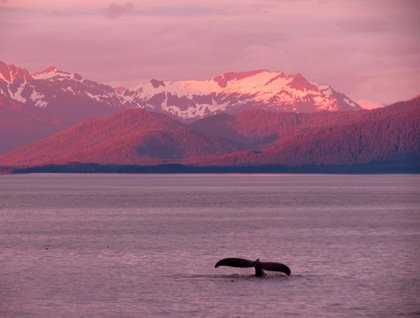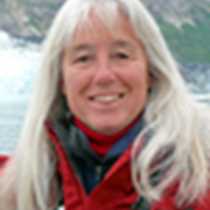We awoke aboard National Geographic Sea Lion this morning to sunshine in picturesque Endicott Arm. With wilderness on all sides, the scenery was bold and stunning, the air crisp and refreshing. Icebergs foreshadowed a glacier ahead; the fjord dead-ends at the face of Dawes Glacier. The Stikeen Icefield feeds glaciers from the border with British Columbia, Canada westward toward the ocean. Those that have their termini in sea water are known as tidewater glaciers. Southeast Alaska is one of the best places to observe tidewater glaciers. The glaciers remaining today are mere remnants of the rivers of ice that carved the channels now plied by many vessels up and down the Inside Passage.
Out on deck we scanned for wildlife with our binoculars, excited about spotting harbor seals on icebergs. They often lift their heads and hind flippers while their blubber-insulated bodies protect them from the cold. This makes them look like large sausages from a distance. Pups born just a few weeks ago have grown fast and are already being weaned. One guest commented that looking through binoculars is like looking into a microscope; both show up-close and personal details.
After breakfast we donned layers of warm clothes and entered our inflatable craft to get a closer look. A cold katabatic wind swooped down off the mass of ice as we approached, moving small icebergs away from the face of the glacier. Harbor seals were comfortable hauled out on rock islets instead. Arctic terns chattered, fished and rested on bits of ice. Some people enjoyed a sighting of a black oystercatcher.
In the afternoon we had a short window of time in which to go through a constricted passage known as Ford’s Terror. Harry Ford explored the area by rowboat in 1889. Entering the narrow waterway in calm water, he had a frightening surprise as the changing tide created waves and whirlpools with icebergs threatening his dory as he exited. Today we entered in our motorized inflatables during a slack low tide and had some time to explore the dramatic splendor of the inner fjord. A few harbor porpoises, harlequin ducks, and an American dipper were seen in this area. By the time the last boat exited, the tide was already flooding in at a good rate.
The remainder of the afternoon was filled with various activities and we were treated to a wine tasting in the lounge before recap and dinner.
The day continued when humpback whales were spotted in Frederick Sound. They lunged at the surface with mouthfuls of krill, and then raised their tail flukes in a graceful slow-motion water ballet. The setting sun set the sky on fire and painted the mountain peaks with alpenglow. Our eyes feasted on a 360-degree panorama of spectacular Alaskan beauty.
National Geographic Sea Lion continued south toward more adventures.







